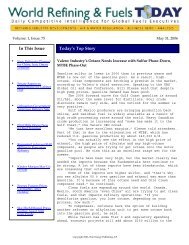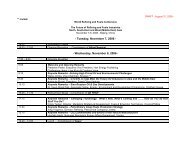ASTM: Gasoline Today and Tomorrow – An Executive Report
ASTM: Gasoline Today and Tomorrow – An Executive Report
ASTM: Gasoline Today and Tomorrow – An Executive Report
You also want an ePaper? Increase the reach of your titles
YUMPU automatically turns print PDFs into web optimized ePapers that Google loves.
Octane Week | <strong>ASTM</strong>: <strong>Gasoline</strong> <strong>Today</strong> <strong>and</strong> <strong>Tomorrow</strong> - <strong>An</strong> <strong>Executive</strong> <strong>Report</strong><br />
<strong>ASTM</strong> Committee Reaches Agreement<br />
on Ethanol Sulfate Specification<br />
This story appeared on December 11, 2006.<br />
After nearly two years of debate, the <strong>ASTM</strong> D02<br />
committee on petroleum fuels has approved three new<br />
test methods in support of a 4 ppm sulfate specification<br />
in D 4806, <strong>ASTM</strong>ʼs denatured fuel ethanol specification.<br />
The final discussions at the Committeeʼs winter meeting<br />
in Orl<strong>and</strong>o, Fla., were characterized as congenial <strong>and</strong><br />
cooperative, as ethanol producers joined with refiners<br />
to make the new methods possible.<br />
<strong>ASTM</strong> will assign identifying numbers to the<br />
new methods probably sometime in December, <strong>and</strong><br />
the specification containing the test methods should be<br />
published by <strong>ASTM</strong> in February, sources tell Octane<br />
Week. “The specification becomes effective when it is<br />
available to the general public,” our source told us.<br />
The three methods, two by ion chromatography<br />
(IC) <strong>and</strong> one by a lead potentiometric titration,<br />
underwent extensive round-robin testing by the D02.03<br />
Subcommittee on Elemental <strong>An</strong>alysis. One set of tests<br />
conducted this spring failed because of sample stability<br />
problems. Sodium sulfate can precipitate out of ethanol<br />
<strong>and</strong> ethanol-blended gasoline, making accurate sulfate<br />
measurements impossible. But the first round robin did<br />
produce acceptable data for measuring up to 50 ppm<br />
total chloride in fuel ethanol using the IC methods,<br />
which is also included in the specification.<br />
Eager to proceed, the 4 ppm specification was<br />
approved by the D02.A Subcommittee on <strong>Gasoline</strong><br />
<strong>and</strong> Oxygenated Fuels in June, pending approval of<br />
one or more of the methods in December. That was<br />
accomplished, so no time was lost by the shortcomings<br />
of the first round robin.<br />
<strong>An</strong>other <strong>ASTM</strong> inter-laboratory study (ILS)<br />
that corrected for the sulfate stability problems was<br />
conducted over the summer. That study included an<br />
oxidation step in the IC methods to convert sulfate that<br />
may have been reduced back to sulfate prior to testing.<br />
This gives a “potential” sulfate result along with the<br />
total sulfate result.<br />
The summer ILS produced positive results,<br />
but study organizers faced another challenge in<br />
compiling a precision statement for one of the IC<br />
methods. Direct injection IC devices utilize different<br />
column suppression configurations <strong>–</strong> tri-chamber <strong>and</strong><br />
continuous. Statisticians could not get all of the data<br />
from the different devices to converge into a single<br />
precision statement for the method. Under intense time<br />
pressure this fall, they reworked the data in a way that<br />
yielded acceptable convergence for the two suppressor<br />
configurations, <strong>and</strong> two precision statements were<br />
added to the method.<br />
By late November, D02 Committee members had<br />
completed balloting of the three methods, all backed by<br />
solid ILS results.<br />
The ballots yielded only three negative votes that<br />
were successfully resolved at last weekʼs meeting.<br />
Two involved a procedural misunderst<strong>and</strong>ing <strong>and</strong> were<br />
withdrawn.<br />
The other negative vote challenged the data pooling<br />
technique for the direct injection IC method, which had<br />
confounded statisticians this fall. “The negative voter<br />
had no problem with the test method, only the way<br />
the data for the precision statement were pooled,” our<br />
source explained. “There is a possible different way of<br />
grouping data in the precision statement, <strong>and</strong> that will<br />
be considered for a method revision this spring.”<br />
With all negatives successfully adjudicated, the<br />
full committee approved the three sulfate test methods<br />
for use in D 4806, bringing a controversial issue to a<br />
successful resolution.<br />
“Ethanol producers are pleased,” said one attendee.<br />
“They were extremely cooperative, participated in the<br />
round robins <strong>and</strong> provided good data. None of them<br />
voted against the ballots.”<br />
Now it is up to Subcommittee A to determine how<br />
the test methods will be listed. Members could make one<br />
test the “primary” method <strong>and</strong> the others “alternative”<br />
methods, or they could say that any of the methods is<br />
acceptable.<br />
All three methods are capable of measuring total<br />
sulfate in concentrations as low as 1 ppm.<br />
The debate over the level of the sulfate specification,<br />
1 ppm versus 4 ppm, was one of the early <strong>and</strong> most<br />
divisive fights among Subcommittee A members.<br />
Refining <strong>and</strong> auto groups support a 1 ppm sulfate limit,<br />
ethanol producers have not to this time. Given ethanol<br />
producersʼ increased membership (continued on p16)<br />
February 2007 15
















